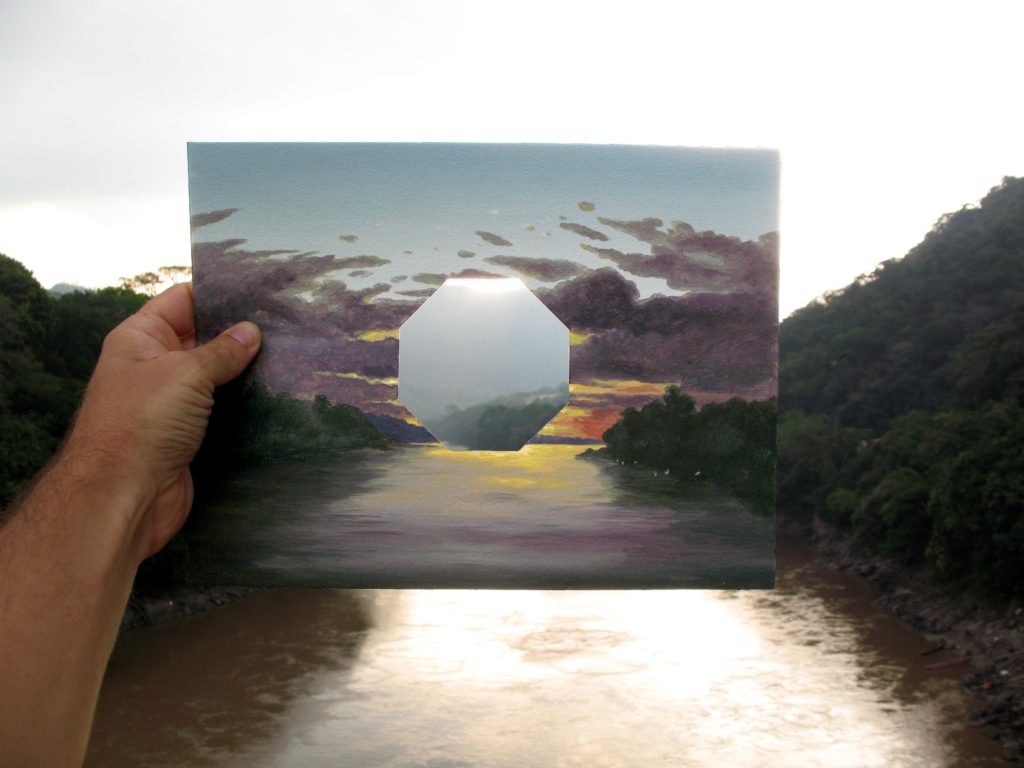Del 15 de febrero al 29 de marzo se presenta en el Gabinete la exposición Fisonomía del tiempo, del artista argentino max Gómez Canle, ganador de la beca entregada por la feria arteBA y la Ciudad de Buenos Aires.
Fisonomía del tiempo
Mas oye do tronando se abre paso
Entre murallas de peinada roca
Andrés Bello
El inconmesurable fluir del río Magdalena parece contraponerse al lento andar de la ciudad de Honda. Dos tiempos que también transcurren distintos a aquellos fijados en los diferentes retratos pictóricos del Magdalena y su paisaje circundante realizados en el transcurso de la historia. En Fisonomía del tiempo, Max Gómez Canle (Buenos Aires, 1972), hace convivir en un cuerpo de pequeños óleos todas estas distintas temporalidades.
Es así, que en las nueve pinturas expuestas, divididas en tres grupos, el artista ensaya diversos intentos por asir la inabarcable fisonomía del río y su paisaje.
Un primer grupo explora aquellos “magdalenas” representados en los estudios fisonómicos de Alexander Von Humboldt, en las crónicas visuales de las tierras exóticas y lejanas de Frederic Edwin Church y en las tardías pinceladas románticas de Jesús María Zamora. Los paisajes se actualizan por medio de ventanas caladas que permiten al ojo buscar y reconocer aquello que todavía queda de aquel otro tiempo.
Un segundo grupo plantea una suerte de estudio científico sobre el comportamiento del río y la niebla a través la superposición de sus fragmentos. Gómez Canle imagina un posible “riometro” que, del mismo modo que el cyanometro- instrumento creado para medir el color del cielo, cuya invención es atribuida al propio Humboldt y a Saussure-, mide en este caso los cambios de color en el río y el paso del tiempo evidente en su superficie.
Un tercer grupo se aproximan a la subjetividad del propio artista. La metáfora del río se activa por medio de asociaciones e imágenes generadas durante el tiempo habitado en Honda; un tiempo que se traduce en paisajes melancólicos, oscuros y tropicales atravesados por la autorreferencialidad, en donde, inclusive, el propio artista parece convertirse en pintura o la pintura en sujeto.
Las nueve pinturas son testigos de la fisonomía cambiante del Magdalena, que se abre paso entre la fisonomía dura y casi inmóvil de las cordilleras, la de una ciudad tropical atrapada en un infinito verano y aquella fijada en los documentos pictóricos de Humboldt, de Church y de Zamora. Max Gómez Canle intenta capturar estas temporalidades; atrapar y medir el imparable caudal del Magdalena por medio de la pintura, pero a través de una pintura que finalmente se rinde, para hundirse y desaparecer en el río.
Pamela Desjardins,
Curadora en Residencia FLORA
—
Max Gómez Canle, Physiognomy of the Time
From February 15th until March 29th the Cabinet presents the exhibition Physiognomy of the Time by the Argentine artist Max Gómez Canle, the winner of the scholarship, conferred by the fair arteBA and the City of Buenos Aires.
It is more possible to hear its thundering way,
Combing between the rocks of the walls.
Andrés Bello
The incomparable flow of the River Magdalena seems to confront itself to the slow walk of the City Honda. Two time measurements that also pass unequal from those fixpoints in the different pictoral portraits of the River Magdalena and its surrounding, made in the course of the history. In Physiognomy of the Time, Max Gómez Canle (Buenos Aires, 1972) puts all these different times together in a group of small oil paintings. The artist examines diverse attempts for seizing the vast physiognomy of the river and its landscape. Therefore, these nine paintings which are exhibit, are divided into three groups.
The first group explores the “Magdalenas” represented in the physionomic studies of Alexander Von Humboldt, in the choricles of exotic and alien groups by Frederic Edwin Church and by Jesús María Zamora, in the late Romantic epoch. The sceneries were updated by open-worked windows that allow to look and recognize what stays today from the other time.
The second group studies the behavior of the river and the fog through the overlap of its fragments. Gómez Canle images a possible “Rivermeter” that – in the same way like a “Cyanometer” – meassures the color of the sky. This invention is simular to the instruments of Humboldt and to Saussure, who measured the changes of the color of rivers and how its surface changes with the passing time.
A third group examines the subjectivity of the artist. The metaphor of the river is made by associations and images generated during the time in Honda – a time that is associated with melancholic, dark and tropical sceneries, different to the reference of the artist, who seems to turn into painting or the painting into a subject.
The nine paintings are witnesses of the changeable physiognomy of the River Magdalena, that opens a way between the hard, almost inmobile physionomy of the mountain ranges, the tropical city with an infinite summer and the pictorial documents by Humboldt, Church and Zamora. Max Gómez Canle tries to capture this temporality to catch and meassure the unstoppable volume of the River Magdalena through the painting, a painting that finally gives up, that sink and disappears in the river.
by Pamela Desjardins, Curator in Residence
